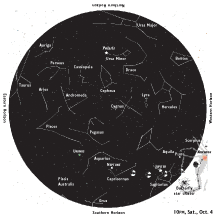 |
|
Sky Watch by J. Alex Knoll The Scorpion and the ButterflyThese stars are setting fast
As the sky darkens after sunset, around 6:45 this week, Venus appears low in the west-southwest and sets before 8pm. Night by night it appears more clearly, but not as a result of pulling farther from the horizon but of sunset coming 10 minutes earlier over the next week. Twilight finds Jupiter above the southern horizon. Nestled amid the dim stars of teapot-shaped Sagittarius, there’s no mistaking Jupiter, which is the brightest object visible — other than the moon — until setting in the southwest around midnight. The waxing crescent moon sets early at week’s end, too. Friday it’s joined by red Antares, which trails the moon by less than 10 degrees. Saturday evening, the two have swapped places, with Antares now the same distance ahead of the moon. The red-giant heart of Scorpio, Antares is juxtaposed in the heavens with the red-giant Betelgeux in the constellation Orion. Each fall, as the scorpion sets in the west, the great hunter rises in the east, bringing winter with him. More than 600 light years from us yet appearing as the 13th brightest star in the heavens, Antares is truly a giant. It is the 10th largest known star in the galaxy, some 700 times the size of our sun, and, were the two swapped, would consume the inner planets and reach halfway to Mars. Antares shines nearly 10,000 times brighter than our sun — in the visible spectrum. Add in this red-giant’s infra-red radiation and it is some 65,000 times more luminous than the sun. Look above Antares, in the scorpion’s tail, for a fuzzy patch of light, the Butterfly star cluster, M4. Made up of approximately 130 stars and some 1,400 light years away, this grouping is one of the farthest objects visible to the naked eye. Illustration: © Copyright 1925 M.C. Escher/Cordon Art-Baarn-Holland; Graphics: © Copyright 2007 Pacific Publishers. Reprinted by permission from the Tidelog graphic almanac. Bound copies of the annual Tidelog for Chesapeake Bay are $14.95 ppd. from Pacific Publishers, Box 480, Bolinas, CA 94924. Phone 415-868-2909. Weather affects tides. This information is believed to be reliable but no guarantee of accuracy is made by Bay Weekly or Pacific Publishers. The actual layout of Tidelog differs from that used in Bay Weekly. Tidelog graphics are repositioned to reflect Bay Weekly’s distribution cycle.Tides are based on National Oceanic and Atmospheric Administration and are positioned to coincide with high and low tides of Tidelog. |
|
|
|
|
|
© COPYRIGHT 2008 by New Bay Enterprises, Inc. All rights reserved. |


